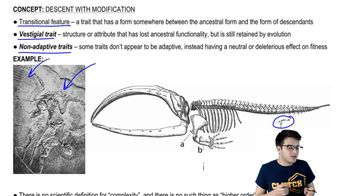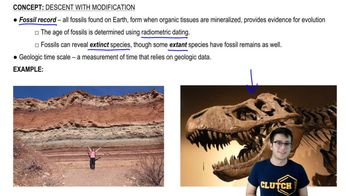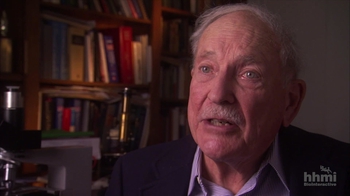Table of contents
- 1. Introduction to Biology2h 40m
- 2. Chemistry3h 40m
- 3. Water1h 26m
- 4. Biomolecules2h 23m
- 5. Cell Components2h 26m
- 6. The Membrane2h 31m
- 7. Energy and Metabolism2h 0m
- 8. Respiration2h 40m
- 9. Photosynthesis2h 49m
- 10. Cell Signaling59m
- 11. Cell Division2h 47m
- 12. Meiosis2h 0m
- 13. Mendelian Genetics4h 41m
- Introduction to Mendel's Experiments7m
- Genotype vs. Phenotype17m
- Punnett Squares13m
- Mendel's Experiments26m
- Mendel's Laws18m
- Monohybrid Crosses16m
- Test Crosses14m
- Dihybrid Crosses20m
- Punnett Square Probability26m
- Incomplete Dominance vs. Codominance20m
- Epistasis7m
- Non-Mendelian Genetics12m
- Pedigrees6m
- Autosomal Inheritance21m
- Sex-Linked Inheritance43m
- X-Inactivation9m
- 14. DNA Synthesis2h 27m
- 15. Gene Expression3h 20m
- 16. Regulation of Expression3h 31m
- Introduction to Regulation of Gene Expression13m
- Prokaryotic Gene Regulation via Operons27m
- The Lac Operon21m
- Glucose's Impact on Lac Operon25m
- The Trp Operon20m
- Review of the Lac Operon & Trp Operon11m
- Introduction to Eukaryotic Gene Regulation9m
- Eukaryotic Chromatin Modifications16m
- Eukaryotic Transcriptional Control22m
- Eukaryotic Post-Transcriptional Regulation28m
- Eukaryotic Post-Translational Regulation13m
- 17. Viruses37m
- 18. Biotechnology2h 58m
- 19. Genomics17m
- 20. Development1h 5m
- 21. Evolution3h 1m
- 22. Evolution of Populations3h 52m
- 23. Speciation1h 37m
- 24. History of Life on Earth2h 6m
- 25. Phylogeny2h 31m
- 26. Prokaryotes4h 59m
- 27. Protists1h 12m
- 28. Plants1h 22m
- 29. Fungi36m
- 30. Overview of Animals34m
- 31. Invertebrates1h 2m
- 32. Vertebrates50m
- 33. Plant Anatomy1h 3m
- 34. Vascular Plant Transport2m
- 35. Soil37m
- 36. Plant Reproduction47m
- 37. Plant Sensation and Response1h 9m
- 38. Animal Form and Function1h 19m
- 39. Digestive System10m
- 40. Circulatory System1h 57m
- 41. Immune System1h 12m
- 42. Osmoregulation and Excretion50m
- 43. Endocrine System4m
- 44. Animal Reproduction2m
- 45. Nervous System55m
- 46. Sensory Systems46m
- 47. Muscle Systems23m
- 48. Ecology3h 11m
- Introduction to Ecology20m
- Biogeography14m
- Earth's Climate Patterns50m
- Introduction to Terrestrial Biomes10m
- Terrestrial Biomes: Near Equator13m
- Terrestrial Biomes: Temperate Regions10m
- Terrestrial Biomes: Northern Regions15m
- Introduction to Aquatic Biomes27m
- Freshwater Aquatic Biomes14m
- Marine Aquatic Biomes13m
- 49. Animal Behavior28m
- 50. Population Ecology3h 41m
- Introduction to Population Ecology28m
- Population Sampling Methods23m
- Life History12m
- Population Demography17m
- Factors Limiting Population Growth14m
- Introduction to Population Growth Models22m
- Linear Population Growth6m
- Exponential Population Growth29m
- Logistic Population Growth32m
- r/K Selection10m
- The Human Population22m
- 51. Community Ecology2h 46m
- Introduction to Community Ecology2m
- Introduction to Community Interactions9m
- Community Interactions: Competition (-/-)38m
- Community Interactions: Exploitation (+/-)23m
- Community Interactions: Mutualism (+/+) & Commensalism (+/0)9m
- Community Structure35m
- Community Dynamics26m
- Geographic Impact on Communities21m
- 52. Ecosystems2h 36m
- 53. Conservation Biology24m
21. Evolution
Introduction to Evolution and Natural Selection
Problem 1e
Textbook Question
Textbook QuestionTrue or false? Some traits are considered vestigial because they existed long ago.
 Verified step by step guidance
Verified step by step guidance1
Determine the definition of 'vestigial traits': Vestigial traits are physical characteristics in organisms that have lost all or most of their original function in a species through evolution.
Understand the context of the statement: The statement suggests that traits are considered vestigial because they existed long ago, implying a historical aspect to their classification.
Analyze the accuracy of the statement: While it is true that vestigial traits are often from ancestors, the key aspect of a trait being vestigial is not its age, but its reduced or non-existent functionality in the organism.
Clarify the misconception: The age of the trait is not the primary reason it is considered vestigial; rather, it is the lack of current function that defines a trait as vestigial.
Conclude the truth value: False. The statement is misleading because it focuses on the age of the trait rather than its lack of function, which is the critical factor in defining a trait as vestigial.
Recommended similar problem, with video answer:
 Verified Solution
Verified SolutionThis video solution was recommended by our tutors as helpful for the problem above
Video duration:
3mPlay a video:
Was this helpful?
Key Concepts
Here are the essential concepts you must grasp in order to answer the question correctly.
Vestigial Traits
Vestigial traits are anatomical structures or behaviors that have lost most or all of their original function through the course of evolution. Examples include the human appendix and the remnants of pelvic bones in whales. These traits provide evidence of an organism's evolutionary history, indicating adaptations that were once beneficial but are no longer necessary.
Recommended video:
Guided course

Vestigial Traits and Evolutionary Misconceptions
Evolutionary Biology
Evolutionary biology is the study of the processes that have led to the diversity of life on Earth. It encompasses concepts such as natural selection, genetic drift, and speciation. Understanding evolutionary biology is crucial for interpreting how vestigial traits arise and persist in populations over time, reflecting changes in environmental pressures and survival needs.
Recommended video:

History of Evolutionary Theory Example 1
Ancestral Traits
Ancestral traits are characteristics that were present in a common ancestor of a group of organisms. These traits can be passed down through generations, even if they become less useful or functional. Recognizing ancestral traits helps scientists understand the evolutionary relationships between species and the historical context of vestigial traits.
Recommended video:
Guided course

Vestigial Traits and Evolutionary Misconceptions

 4:58m
4:58mWatch next
Master Evolution and Natural Selection with a bite sized video explanation from Bruce Bryan
Start learningRelated Videos
Related Practice































